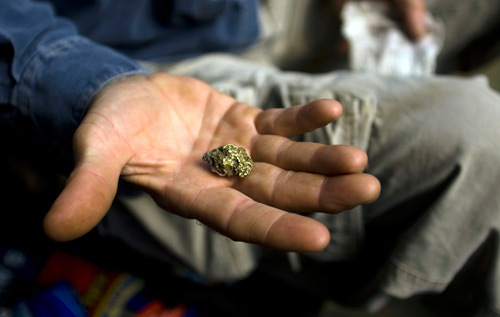
Source: Nick Duffy for Bermuda Sun
Will Bermuda make it rich on the back of Papua New Guinea's experiment with seabed mining - or will it 'be ground zero for an unprecedented marine catastrophe'?
While many were Americans, the Gold Rush also attracted tens of thousands from Asia, Europe, Australia and Latin America. *MCT photo
It began on January 24, 1848 on the banks of the South Fork American River at a small sawmill. The mill was owned by 19th century pioneer John Sutter and his foreman James W. Marshall.
The mill was located in Coloma, California and the discovery that day resulted in the migration of over 300,000 people over the course of the next seven years. It was the start of The California Gold Rush (1848–1855).
The gold-seekers, called ‘forty-niners’ (as a reference to 1849), faced great hardships on the journey to the goldfields. While many were Americans, the Gold Rush also attracted tens of thousands from Asia, Europe, Australia and Latin America.
At first, the gold nuggets could be picked up off the ground and later recovered from streams and riverbeds using simple techniques such as panning, but as the gold became harder to find, more sophisticated methods had to be developed. By the peak of the gold rush, technological advances required significant infrastructure and financing to search for the gold. When it was all over, San Francisco had grown into a settlement of over 25,000 people and gold worth tens of billions at today’s value had been recovered, which led to great wealth for a few.
However, many returned home with little more than broken dreams and empty pockets.
Just over forty years later, between 1896 and 1899, a second stampede involving over 100,000 prospectors took place in an even more hostile environment when gold was discovered in the Klondike region of the Yukon in north western Canada.
To reach the gold fields most took the route through the ports of Dyea and Skagway in Southeast Alaska.
Here, the Klondikers could follow either the Chilkoot or the White Pass trails to the Yukon River and sail down to the Klondike.
Each of them was required to bring a year’s supply of food by the Canadian authorities to prevent starvation.
In all, their equipment weighed close to a ton, which, for most, had to be carried in stages over the passes.
The combination of mountainous terrain and frigid conditions meant that only 30,000 to 40,000 finally arrived, a full year after starting their journey.
That was well over a century ago but history has an uncanny way of repeating itself and we are now on the verge of the 21st century ‘global’ version of the ‘Gold Rush’.
This time it is beginning in the remote south eastern Pacific Ocean in the waters surrounding the island nation of Papua New Guinea where a Canadian mining company (Nautilus Minerals) has just finalized an agreement with the government of Papua New Guinea to commence deep-ocean mining on the seabed in an area of their territorial waters.
The mine will be at a depth of almost 5,000 ft. and will target hydrothermal vents gushing superheated, highly acidic, mineral rich water from the seabed. When the superheated water collides and mixes with colder more alkaline seawater, high concentrations of minerals are released from the solution. The result is a surrounding seabed that is far richer in gold, copper and other valuable minerals than typical in surface mines.
Historically, the idea of mining these mineral-rich areas of the seabed were dismissed as unfeasible however, the recent boom in deep offshore gas and oil production has stimulated the development of advanced deep sea technologies. At the same time, unprecedented demand for consumer electronics has driven the global price for ‘rare earth’ materials to unprecedented highs.
The mine, known as Solwara-1, will be excavated using robotic machines controlled from a ‘mother ship’ at the surface.
The International Seabed Authority (ISA), the UN body policing this emerging industry, has welcomed the Nautilus Minerals agreement with Papua New Guinea and is currently drawing up guidelines for the environmental management of future seabed mining.
To date, the ISA has issued 20 exploration licences to search for undersea minerals. What is critical is to find balance between the economic opportunities of deep-sea mining and the need to prevent the environmental damage that seabed mining could create.
If managed correctly, Bermuda could be at the epicentre of a 21st century Klondike, creating billions of new wealth.
Get it wrong and we could be ground zero for an unprecedented marine catastrophe
- Elizabeth1's blog
- Log in to post comments
